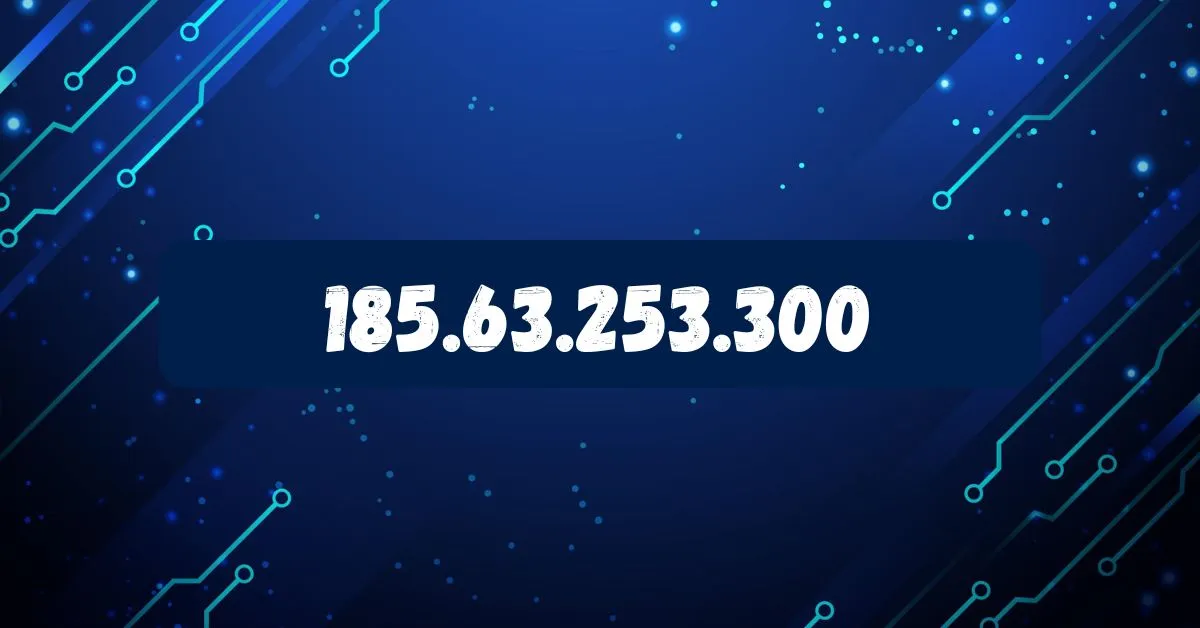185.63.253.300 appears to be an IP address, but it is not a valid one because the last part, “300”, exceeds 255. This makes it unusable for real networking, but it is often used as an example.
In this guide, we break down everything you need to know about 185.63.253.300 and uncover its top secrets
What is an IP Address?
An IP address (Internet Protocol address) is a unique set of numbers unique to every device connected to the internet. The digital address enables computers, servers, and websites to communicate with each other.
There are two main types of IP addresses:
- IPv4 (Internet Protocol version 4): Uses four sets of numbers separated by dots (e.g., 192.168.0.1). Each number ranges from 0 to 255.
- IPv6 (Internet Protocol version 6): Uses a longer character format to support more devices as the internet grows.
The IP address 185.63.253.300 follows the IPv4 format, but it has an important catch we will uncover shortly.
Breaking Down 185.63.253.300
To better understand it, you can split it into four parts:
- 185
- 63
- 253
- 300
Each segment in an IPv4 address must fall between 0 and 255. Numbers outside of this range are invalid. Here, the last part “300” goes beyond the limit, which makes 185.63.253.300 an invalid IPv4 address.
Is 185.63.253.300 a Valid IP Address?
The short answer is no.
Since IPv4 addresses only allow numbers from 0 to 255, the last section (300) makes this address impossible to use on the internet. If you try to enter it in a browser, it cannot lead to a website or server.
Why Do People Search for 185.63.253.300?

Even though the address is invalid, many people still search for 185.63.253.300. Here are some possible reasons:
- Typographical Errors: Someone might have intended to type 185.63.253.30 or 185.63.253.3, which could be valid.
- Misconfigured Systems: Software or network devices may sometimes display wrong IP addresses.
- Learning Purposes: Students, IT beginners, or cybersecurity enthusiasts may use it as an example.
- Curiosity: Since the number looks like a real IP, people often want to confirm if they are genuine.
How to Check if an IP Address is Real
If you ever come across an IP like 185.63.253.300 and want to know if this is real, here are some quick methods:
- Ping the Address: Use the command prompt or terminal (ping 185.63.253.300). A real IP will respond, but this one will not.
- Use WHOIS Lookup: Tools like ARIN, RIPE, or online IP checkers reveal ownership details of valid IP addresses.
- Check Format: Remember, in IPv4, each part must be between 0 and 255.
The Difference Between a Valid and Invalid IP

- Valid IP Example: 185.63.253.200 → Could point to a server in Europe.
- Invalid IP Example: 185.63.253.300 → Cannot exist because “300” exceeds the maximum allowed value.
This makes 185.63.253.300 invalid, but addresses that look similar may actually be real.
Can Hackers Use Fake IPs Like 185.63.253.300?
Cybercriminals sometimes use fake IPs for confusion, testing, or scams. While 185.63.253.300 itself cannot function as a real IP, hackers might display such numbers in:
- Phishing emails to trick users.
- Fake server logs to hide their identity.
- Test environments where they will not need real connections.
So, while you do not need to worry about this specific number, you should always be good to remain careful with suspicious IPs.
The Role of IPs in Cybersecurity
IP addresses play a major role in tracking, blocking, and securing networks. For example:
- Firewalls block malicious IPs.
- Security tools monitor unusual IP activity.
- Companies whitelist safe IPs for access.
Since 185.63.253.300 is invalid, it will not appear in real security reports, but understanding IPs helps you recognize real threats.
Common Mistakes with IP Addresses
Here are some frequent errors people make when dealing with IPs:
- Adding extra digits (185.63.253.300 instead of 185.63.253.30)
- Using spaces instead of dots
- Mixing up IPv4 with IPv6
- Forgetting that private IPs (like 192.168.x.x) will not work outside local networks
Avoiding these mistakes ensures smoother internet connections.
Alternatives to 185.63.253.300
If you came across this number while troubleshooting, here are valid alternatives to check:
- 185.63.253.30
- 185.63.253.3
- 185.63.253.200
These follow the correct IPv4 rules and could point to actual servers.
How to Stay Safe Online with IP Addresses
Even if you encounter invalid IPs, practicing online safety is important. Here are some tips:
- Always verify unknown IPs with trusted lookup tools.
- Use a VPN to hide your own IP and protect privacy.
- Report unknown addresses in emails or messages.
- Keep your antivirus and firewall updated.
FAQs
Is 185.63.253.300 a real IP address?
No, it is invalid because the last number “300” exceeds the maximum limit of 255.
What happens if I enter 185.63.253.300 in my browser?
Nothing will load since the address did not exist.
Why does this IP appear online if it’s not valid?
It could be due to typing errors, misconfigured systems, or learning examples.
Can I use 185.63.253.300 for my own server?
No, because invalid IPs cannot be assigned to any device.
How do I check if an IP address is valid?
Ensure each section is between 0–255 and test with tools like ping or WHOIS.
Conclusion
The IP address 185.63.253.300 may look real, but in reality, it is invalid because one of its sections goes beyond the IPv4 limit. Many people search for it due to typos, curiosity, or misconfigurations, but it cannot connect to any website or server.
By learning about IP addresses and how they work, you can better understand the digital world and protect yourself from confusion or scams. Next time you come across an unusual address like 185.63.253.300, you’ll know exactly why it doesn’t function and how to verify if an IP is valid.
Also Read:
Cancún FC vs. Santos – Don’t Miss the Thrilling Match Breakdown!



